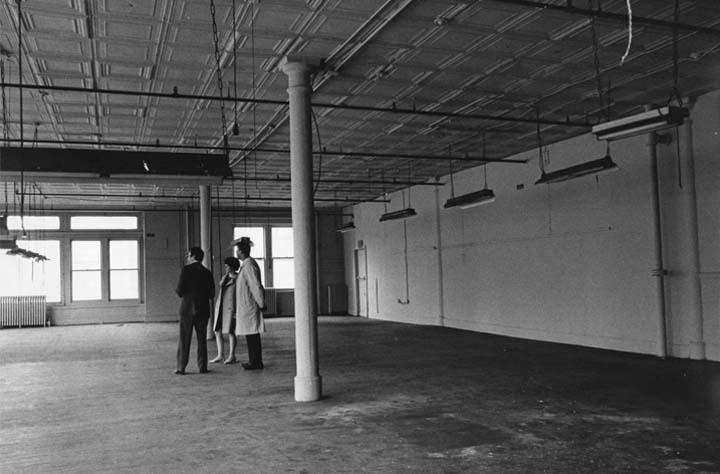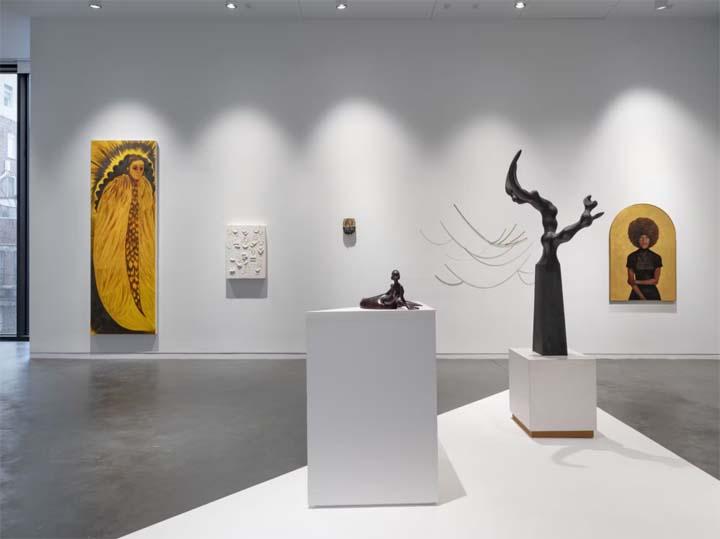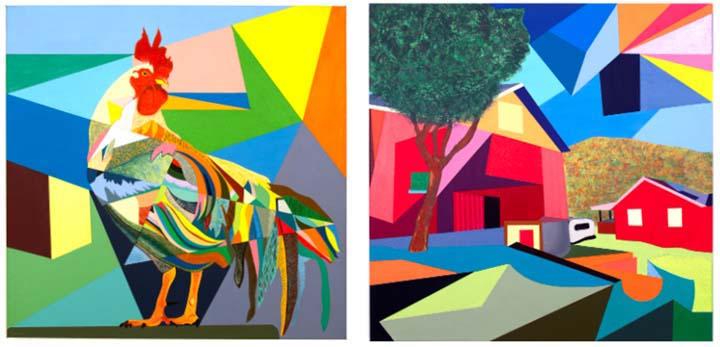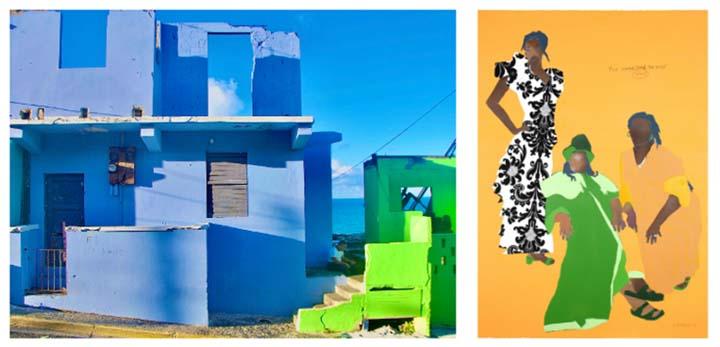UPDATE: The Studio Museum in Harlem
The Studio Museum in Harlem
After seven years of construction, the Studio Museum of Harlem opened its new doors on Sunday, with an all-day celebration of artists who created this center for Black culture and the community that grew around it. Speaking at a press opening, Director and Curator Thelma Golden said, “We chose to build this completely new home on the same ground where we stood for so many years. We could’ve looked for a different site in Harlem. We could have relocated to a space in an existing building. But we knew, and our public knew, tat this site, which the museum has occupied since the early ‘80s, is where we belong.” Above: Exterior of the Studio Museum in Harlem's new building. Photo: © Albert Vecerka/Esto; below: Interior of the Studio Museum in Harlem's new building, featuring Glenn Ligon's Give Us a Poem (2007), 2025. Photo: © Albert Vecerka/Esto
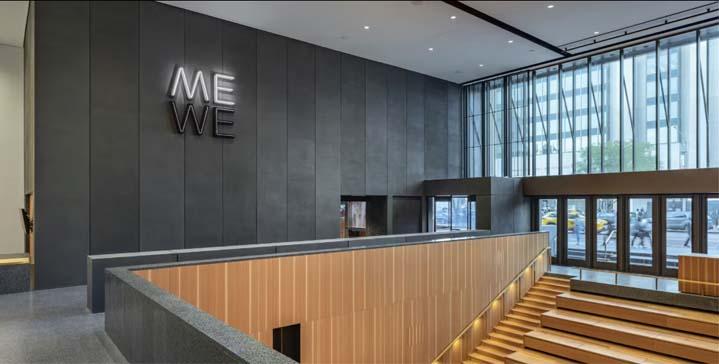
“We are rooted in 125th Street,” she continued, “just as we are rooted in the history, the heritage, the imagination, and the inspiration of all those who came before. Today, we welcome a new future for ourselves by staying true to our past.”
Founded by a diverse group of artists, activists, philanthropists, and Harlem residents, with Charles E. Inniss as its Director, the Studio Museum in Harlem celebrated its opening on September 24, 1968, at its first home—a second story rental over a liquor store at 2033 Fifth Avenue. The name signified that this was to be a vital resource for Black artists finding their way to both make and present their work to a previously overlooked public. This was also the beginning of an artist in residence program that gave its nave to the museum and charted its course. Above: Inside the Studio Museum in Harlem's original location at 2033 Fifth Avenue, c. 1968
In the 1980s the Studio Museum settled in to the 60,000 square-foot New York Bank of Savings on what is the site of the new building. Here the museum took permanent roots and began to develop more of the education and public programs which have become models of their kind. Globally, it became known for helping launch the careers of up-and-coming artists such as Kehinde Wiley, Mickalene Thomas, and David Hammons through its artist-in-residence program. Locally, it became institutionalized as the place to witness Black art and to see the Black experience enshrined through its educational and family programs. In 2005, Thelma Golden became the Director and Chief Curator, and launched a new series of programs, including the VideoStudio, admission-free Sudays, and the Studio Museum/MoMA fellowship program, among others. You can follow key moments in its history here Above: Ritual and Myth: A Survey of African-American Art (installation view) at the Studio Museum in Harlem, 1982
By the 20-teens, the museum had outgrown its space and made the tough decision to raze the structure in order to build anew on its historic location. By 2017 Studio Museum had raised $175 million in a capital campaign to create an entirely new building on the same site. To date, it has raised more than $300 million to secure not just the building but the future sustainability of the museum as part of its Creating Space Campaign.During the seven-year interim, which was exacerbated by the Covid lockdown s, the organization’s seemingly built-in capacity for improvisation clicked in. Its vital Residency program continued off-site and partnerships with MoMA PS1, The Schomburg Center for Black History and The Metropolitan Museum of Art, to name a few, enable the continuation of its core education and exhibition programs.
The Studio Museum’s opening exhibitions begin with the late sculptor, arts worker, activist, and community organizer Tom Lloyd, whose solo exhibition Electronic Refractions II inaugurated the Studio Museum in September 1968. Tom Lloyd will span 20 years of the artist’s career, delving into his pioneering use of electric light and contributions to the intersecting landscapes of technology and art. Above: Tom Lloyd (installation view), 2025. Photo: © Albert Vecerka/Est
The Studio Museum’s reopening will also feature a rotating, thematic installation of artworks from its permanent collection; an exhibition of works on paper by more than 100 alumni of its Artist-in-Residence program; and a show of archival photographs and ephemera exploring the museum’s nearly six-decade history. New commissions by Camille Norment and Christopher Myers will be displayed throughout the museum’s public spaces alongside reinstallations of iconic works, such as David Hammons’s “Untitled (African American Flag)” (2004), first raised outside the institution in 2004. Above: From Now: A Collection in Context (installation view), 2025. Courtesy Studio Museum in Harlem. Photo: Kris Graves
“In many ways I do feel the timing of our opening now is ideal,” Director Thelma Golden said. “We're opening in a moment that's very much like the moment when the museum was founded….It was always this museum's goal to be a home for Black art. And the collection really represents a cross-generational, amazing conversation between artists who made works over 100 years ago, and artists who are making work right now.”
The museum’s new home offers a custom-built canvas to showcase rotating works from its resident artists and its 9,000-piece permanent collection. Find out more in this video: Unpacking the Studio Museum. All images courtesy of The Studio Museum of Harlem
The Studio Museum in Harlem, 144 West 125th Street, New York, NY Info
While you’re in the neighborhood….
Friday, November 7, 6-8 pm, Opening Reception: We AmeRícans at Claire Oliver
Curated by acclaimed photographer and curator Ruben Natal-San Miguel, We AmeRícans features artists whose practices span painting, photography, sculpture, printmaking, textiles, and mixed media, creating a multivocal portrait of Puerto Rican identity and its diasporic reach. Opening during National Puerto Rican Heritage Month, the exhibition draws historical grounding from the Great Migration of Puerto Ricans to New York City, a transformative wave beginning in the mid-20th century when hundreds of thousands migrated from Puerto Rico to the United States.
Factors such as economic hardship, increased job opportunities in New York, and the accessibility of air travel fueled this movement, making New York City the largest Puerto Rican cultural center outside of the island. By the mid-1960s, more than one million Puerto Ricans had settled in the United States, with the majority residing in New York City. Above left: Dave Ortiz, Gallo, 2025; above right: Dave Ortiz, Barnito Vicente, 2025
The exhibition title is inspired by the celebrated 1985 poem We AmeRícan by Tato Laviera, a pioneering Nuyorican poet whose work embraced cultural hybridity, identity, and pride. These works collectively reflect the history, resilience, and cultural contributions of the Puerto Rican community in New York City and beyond “This exhibition is a celebration and an act of preservation, documenting the creativity, strength, and ongoing impact of Puerto Rican artists across generations,” says curator and artist Ruben Natal-San Miguel. “Through their work, we see not just personal narratives, but the collective story of migration, labor, resilience, and cultural pride.” Above left: Ruben Natal-San Miguel, Home Ruins, La Perla, Old San Juan, Puerto Rico, 2017; above right: Erica Morales, You're Gonna Lose The House, 2024
fClaire Oliver Gallery, 2288 Adam Clayton Powell Jr. Boulevard, New York, NY Info
If you would like to subscribe to DART: Design Arts Daily, please go here




